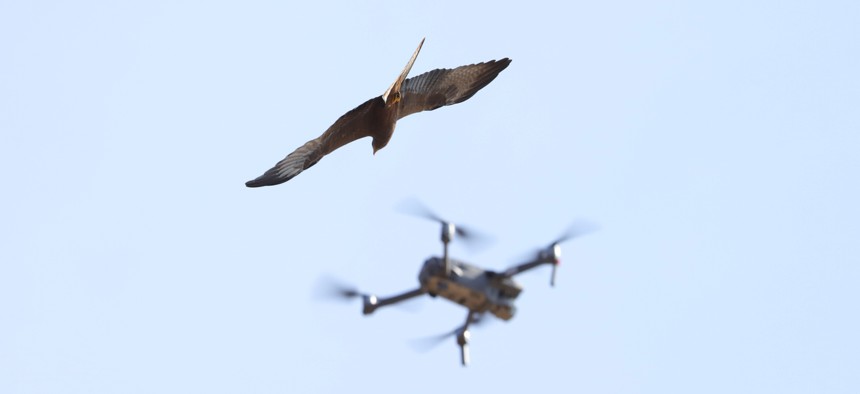State Officials to Drone Operators: Please Stop Harassing the Animals

istockphoto.com/Africanway
Wildlife officials in Colorado this week urged recreational drone pilots to avoid disrupting animals during flights, the latest example of a growing issue for state agencies.
Wildlife officials in Colorado are urging recreational drone pilots to be courteous of wildlife when they fly in nature, cautioning that the noise and movement from unmanned aerial vehicles can be distressing for animals.
“Many animals are preyed upon by the air and can be distressed by drones flying above them. Wild animals are always hyper-aware of their surroundings because of their survival instincts. If there is a mother with young, there will likely be even more heightened reaction to the presence of drones,” Colorado Parks and Wildlife said in a news release. “Additionally, many birds of prey see drones as a predator competing for food. Those using drones should maintain distance from wild animals and be on the lookout for signs of agitation.”
The agency said the reminder was issued after wildlife officials noticed an uptick in animals being disturbed by drone activity. In many cases, pilots aren’t aware of the disturbance they’re causing, and many don’t know the rules and regulations limiting drone usage on state lands. For example, drones can’t be used for hunting or launched or landed in state wildlife areas, and they can only be used in state parks with areas designated for model aircraft use.
Even in areas where drones can be flown legally, any usage that harasses wildlife—intentional or not—is illegal, said Heather Dugan, field services assistant director for the state agency.
“The definition of harassment is causing any change in the behavior of the wildlife,” she said in a statement. “So if the animal runs, if it changes direction, if it stops eating, that's harassment. Any change in the animal is considered harassment and it’s illegal.”
Striking a Balance
Striking a balance between drone hobbyists and wildlife conservation is a growing issue for states across the country as the unmanned aircrafts continue to grow in popularity. Roughly 1.14 million recreational drone operators had registered with the Federal Aviation Administration as of November 2020, more than eight times the number in June 2015, according to federal data. Because operators often have more than one autonomous vehicle or may not register their equipment as required, the FAA estimated in December that “the number of recreational aircraft is almost 30% higher than ownership registration.”
Regulations for drone operation are fairly uniform in federal parks and wildlife preserves. The vehicles cannot be launched, landed or flown over land or waters managed by the National Park Service, and operators need a special permit to fly them inside the National Wildlife Refuge System, which is managed by the U.S. Fish and Wildlife Service. But state and local laws are more piecemeal.
In California, for example, drones are allowed in state parks, beaches, historic parks, recreational and vehicular recreation areas except where prohibited by “a district superintendent’s posted order,” according to the state Department of Parks and Recreation. But the aircraft are illegal in nature preserves overseen by the state Department of Fish and Wildlife, unless operators have a special permit.
Operators often aren’t aware of the differences, which can lead to wildlife disruption. In May, for example, an estimated 2,000 elegant tern eggs were abandoned by nesting birds when two drones crashed into a nonprofit nature conservancy in Huntington Beach, California.
“It is believed that the nesting terns left the eggs they were incubating in a response to the threat that the drone posed,” the Bolsa Chica Conservatory said on Twitter. “This has never happened at such a large scale at the reserve.”
The California Department of Fish and Wildlife said it would partner with the Huntington Beach Police Department to educate drone operators on existing state regulations as well as how to operate their aircraft safely. In a June 4 Facebook post, the agency said it was visiting the preserve for an outreach program when a “drone pilot unintentionally helped make the point” by flying an aircraft over the protected area. The pilot was cited, the agency said.
Implementing Formal Policies
Education and outreach is the most common method of deterrence, though some states are moving to make more formal policies. Oregon will draft official rules governing drone flights by next summer, a policy shift mandated in legislation approved by lawmakers this spring. As written, the bill, signed into law by Gov. Kate Brown in June, gives the state Parks and Recreation Department the authority to regulate the use of “unmanned aircraft systems by people in state parks to protect natural, cultural, scenic and recreational resources” while still allowing the department itself to use drones to carry out its duties.
Drones can be useful for conservation purposes and can allow outdoors enthusiasts to take in sweeping vistas and sights they may not otherwise be able to experience, said Brian Dreher, a terrestrial section manager with Colorado Parks and Wildlife. But drone operators should take time to ensure their hobby isn’t interfering with nature, he said.
“Drones can provide incredible insight to the landscape around us by producing views typically unseen by the majority of people. It’s important for drone operators to understand their surroundings including the impacts to people’s privacy and wildlife health,” Dreher said in a statement.
“Part of being a Coloradan is respecting the natural environment around us,” he added. “As people pick up drone use as a hobby, they also need to understand the importance of conservation ethics.”
Kate Elizabeth Queram is a senior reporter for Route Fifty and is based in Washington, D.C.
NEXT STORY: Governor Has Oversight of Mask Decisions, A State Supreme Court Rules





